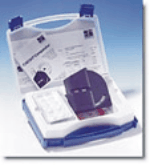



Water analysis
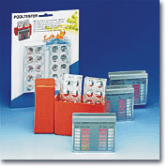 |
Chemical analysis for swimming poolsThe reliable testing routine to ensure healthy water in private swimming pools and hot whirlpools POOLTESTER Chlorine-pH: allows simultaneous determination of free chlorine (either over the measuring range 0.1 - 3 mg/l or 0.5 - 6 mg/l) and pH value (6.8 - 8.2) using Lovibond® tablet reagents with long-term stability. The disinfecting potential of the chlorine kills germs quickly and reliably, while its oxidation potential ensures degradation of organic pollutants. POOLTESTER Bromine-pH: is used to measure the concentration of bromine (1– - 8 mg/l) and pH value (6.8 - 8.2) where, for example, bromine sticks are used as disinfecting agents. POOLTESTER Active oxygen-pH: is used to measure active oxygen content (0 - 10 mg/l) and pH value (6.8 - 8.2). POOLTESTER QAC-pH: is used to measure QAC content (25 - 150 mg / l) and pH value (6.8 - 8.2). POOLTESTER Biguanide/Hydrogen Peroxide-pH: measures the pH value (6.8 - 8.2) and the concentration of biguanide (PHMB 10 - 100 mg / l), (various trade names are used for biguanide). A further water treatment agent with disinfection and oxidation potential is hydrogen peroxide, which is measured over the range 5 - 50 mg / l H2O2. POOLTESTER Copper-pH: allows measurement of copper concentration (0.1 - 0.9 mg / l) and pH value (6.8 - 7.8). Copper is used as an algicide to prevent algae formation or to remove existing algae in water.
|
||||||||||||||||||||||||||||||||||||||||||||||||||||||||||||||||
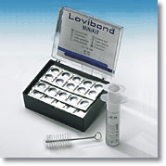 |
Chemical analysis with the MINIKIT®Quick, simple tests for the analysis of boiler water, cooling water, drinking and industrial water. Using tablet reagents with long-term stability. Advantages: easy operation and exact reagent dosing without any additional equipment, measurement accuracy even in difficult operating environments, unrestricted shipment and safe storage, foil-wrapped Lovibond® tablet reagents with a minimum guaranteed shelf life of 5 years, each kit contains sufficient reagents for an average 30 tests. The methods Tablet count method: the liquid titration solution and indicator are replaced by Lovibond® tablet reagents. A specific number of tablets is added to a defined sample volume until a chemically induced colour change takes place. The concentration of the parameter being measured is calculated from the number of tablets required. The measuring range can be expanded by varying the sample volume. Speed test: is based on reverse titration. After adding a reagent tablet to a calibrated test tube, the water sample is added slowly until the colour of the solution changes (e.g. from red to blue). The user can then obtain the result from the liquid level. Yes/No test: tells the user whether a specific ingredient is present in the water and/or if its concentration is higher or lower than a defined level. Turbidity method: a two-section calibrated test tube is filled with the water sample and a reagent tablet added. The reagent creates a level of turbidity that is proportional to the concentration of the parameter being measured. The inner tube, which has a black dot on its base, is lowered until the dot is obscured by the turbidity. The result is read off from the water level in the inner tube.
|
||||||||||||||||||||||||||||||||||||||||||||||||||||||||||||||||
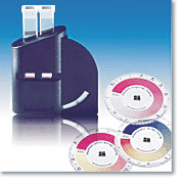
|
Chemical analysis with the CHECKIT®ComparatorWith continuous colour scale low cost - precise - reliable Applications: Water Treatment (e.g. Drinking Water), Pools, Laboratory and Field Testing The CHECKIT®Comparator is a compact, handy colorimetric unit which is suitable both for mobile and stationary analysis work. Supplied with a generous number of different colour scales, it provides the basis for a comprehensive, easy-to-use colorimetric analysis system. The two cells are filled with the water sample and one is placed directly into the left-hand compartment of the comparator, where it acts as compensation (blank) for coloured or cloudy samples. In the second cell, the reagents required for the analysis (tablets, powder or liquids) are mixed with the sample and this cell is then placed in the right-hand compartment of the comparator. The relevant CHECKIT®Disc is inserted in the comparator and turned until the colour standard matches the coloured water sample. The result can then be read in the large display window. The diffuser plate on the rear of the comparator is used to provide compensation for ambient influences and unfavourable lighting conditions. CHECKIT®Disc Each CHECKIT®Disc contains a continuous colour scale which makes it possible to achieve an exact colour match between the colour standard and the sample. These CHECKIT®Discs are specially manufactured in selected materials to remain colour-stability over a long period and guarantee reliable, reproducible measurement results. Instruction manuals explaining the various stages of analysis in simple, straightforward terms, are supplied with each CHECKIT®Disc.
Every kit is delivered in a case with the CHECKIT Comparator, the disc, cuvette, reactant for about 30 analyses. The reactant can be ordered separatly for about 100 analyses.
|
||||||||||||||||||||||||||||||||||||||||||||||||||||||||||||||||
 |
Chemical analysis for swimming poolsThe Scuba is an immersible test device which uses the same technology as is used in public swimming pools. A sample of the water is tested using the photometric principle and the results are shown in the high-precision digital display. The unit has a modern housing designed to meet ergonomic requirements and is, of course, fully watertight. The Scuba is supplied complete with specially formulated, quick-dissolving reagent tablets (identified by their white foil packaging).
|
||||||||||||||||||||||||||||||||||||||||||||||||||||||||||||||||
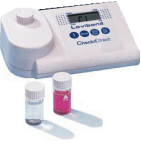 |
Chemical analysis with the CHECKIT®Direct SpectrophotometerAdvantages: automatic zero calibration, rapid measuring cycle (approx. 3 seconds), large digital display, SMD microprocessor technology, LEDs with long-term stability, suitable for use as a testing instrument, uses Lovibond® tablet reagents or vial tests with long term stability, fully equipped unit supplied in a case, automatic switch-off The CheckitDirect models each offer 1 test method, while the CheckitDirect+ units are programmed for a number of different parameters. The CheckitDirect units supply accurate, reproducible results very quickly. Other major advantages include ease of operation, ergonomic design, compact dimensions and safe handling. The LEDs used as a source of light have long-term stability giving monochromatic light emission with low power consumption. As it is battery operated, the unit is suitable for both field and laboratory use. The tests are conducted using either Lovibond® tablet reagents with long-term stability and a guaranteed minimum 5 or 10 year shelf life or using Lovibond® vial tests.
Composition of the kit: Spectrophometer, reagents and accessories. The reagents for about 100 analyses can be ordered separatly. The kits for DCO, Fluorure und... are delivered without reagents.
|
||||||||||||||||||||||||||||||||||||||||||||||||||||||||||||||||
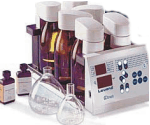
|
OxiDirect BOD-Measurement-System
Respirometric methods provide direct measurement of the oxygen consumed by microorganisms from an air or oxygen-enriched environment in a closed vessel under conditions of constant temperature and agitation. Carbon dioxide produced metabolically by the bacteria is chemically bound by the potassium hydroxide solution contained in the seal cup in the bottle. The result is a pressure drop in the system, which is directly proportional to the BOD value and is measured by the BOD sensor. The BOD level is then displayed directly in mg/l. The BOD values are stored in the sensor memory and can be called up on the large-format display at any time without the need for time-consuming conversion using factors. This means that test series that end on a Sunday can be evaluated during the following week without any problem. The measurement period is user-selectable between 1 and 28 days to suit the application. While short measurement periods are useful for scientific applications, standard BOD measurements typically extend over a period of 5 days – and manometric determination of OECD, for example, generally takes place over a period of 28 days. Automatic start function: variations in sample temperature prior to testing result in pressure variations within the measuring system during the temperature equalisation period in the thermostatically controlled cabinet (if BOD measurement is to take place at 20°C, for example). Such variations would normally cause errors during manometric measurement. In order to prevent such errors, the Lovibond® OxiDirect® BOD meter is equipped with an automatic start feature: measurement does not commence until the temperature in the samples is the same as that in the thermostatically controlled cabinet. This rules out the possibility of temperature (and hence pressure) fluctuations that are not related to the manometric measurement. The complete BOD measuring system: In addition to the BOD unit for measurement and storage of BOD levels, the OxiDirect® BOD measuring system includes sample bottles, measuring sensors, non-wearing inductive stirring system, overflow measuring flasks for metering of sample volumes, nitrification inhibitor and potassium hydroxide as an absorbent.
|
||||||||||||||||||||||||||||||||||||||||||||||||||||||||||||||||

|
Aquaduo: pH and desinfectant (chlorine or brome) measurement
|
||||||||||||||||||||||||||||||||||||||||||||||||||||||||||||||||
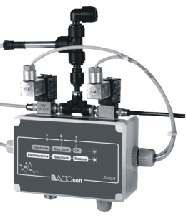 |
Water hardness monitor Bamosoft Smart BAMO
|
||||||||||||||||||||||||||||||||||||||||||||||||||||||||||||||||
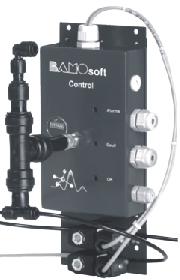 |
Water hardness monitor Bamosoft Control BAMO
|
||||||||||||||||||||||||||||||||||||||||||||||||||||||||||||||||
Chlorine (total) amperometric sensor CP2.1 BAMOPrinciple: Brome measurement by amperometric method with a diaphragm cell of 3 electrodes. The probe includes a CTN sensor for the temperature compensation. The measuring at a constant flow rate requires the use of a specific cell. The water analyzed does not contain surfactants.
|
|||||||||||||||||||||||||||||||||||||||||||||||||||||||||||||||||
Brome amperometric sensor BR1 BAMOPrinciple: Brome measurement by amperometric method with a diaphragm cell of 3 electrodes. The probe includes a CTN sensor for the temperature compensation. The measuring at a constant flow rate requires the use of a specific cell.
|
|||||||||||||||||||||||||||||||||||||||||||||||||||||||||||||||||
Ozone amperometric sensor OZ7 BAMOPrinciple: Ozone measurement by amperometric method with a diaphragm cell of 2 electrodes. The probe includes a CTN sensor for the temperature compensation. The measuring at a constant flow rate requires the use of a specific cell.
|
|||||||||||||||||||||||||||||||||||||||||||||||||||||||||||||||||
Peracetic acid amperometric sensor BAMOAmperometric measurement in a closed cell with 2 electrodes, integrated membrane and NTC temperature. The measuring at a constant flow rate requires the use of a specific cell.
|
|||||||||||||||||||||||||||||||||||||||||||||||||||||||||||||||||
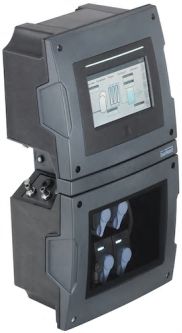 |
On line water analysis with Bürkert T8905The Type 8905 Online Analysis System is a modular system for monitoring all important water parameters on one platform. :pH-value - chlorine, for disinfection purposes, conductivity, indicator for dissolved content/minerals, ORP-value, parameter for oxidation or reduction characteristics of the water, turbidity, indicator for undissolved content, temperature. The extreme modularity allows adding or removing electronic modules or sensor cubes without tools during uninterrupted operation (Hot Swap). . Specifications
|
Oberdorfstrasse 51
CH 3930 Eyholz
tel + 41 27 946 80 18
fax + 41 27 946 86 42
info@sysmatec.ch
